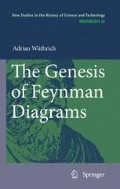Abstract
In the early 1940s, when Feynman was a graduate student, one of the most pressing problems facing theoretical physicists of the time was the fact that infinite and, therefore, uninterpretable quantities arose from some of the principles of electrodynamics—in both classical electrodynamics as well as in the early attempts to establish a quantum theory.1 Roughly, the problem was as follows: an extended electron could not be stable because the charges distributed over its volume would repel each other. On the other hand, a point-like electron would imply that the energy contained in the electron’s electrostatic field would be infinite, since the field energy e/r diverges in the limit of vanishing radius r of the spatial distribution of the charge e.2
But what does the quantum mechanician do if he cannot be provided with a Hamilton operator? He goes on strike.
Heinrich Leutwyler
Lecture notes ‘Elektrodynamik und Optik’ (p. 21)
Translation A. W.
Access this chapter
Tax calculation will be finalised at checkout
Purchases are for personal use only
Notes
- 1.
For a comprehensive account of the history of QED, see Schweber (1994).
- 2.
- 3.
- 4.
Feynman (2005), Introduction.
- 5.
Only a summary of a presentation of Wheeler and Feynman’s theory had been published by the time Feynman started working on his thesis (see “Minutes of the Cambridge, Massachusetts, Meeting, February 21 and 22, 1941”, p. 683). The published accounts of the theory are Wheeler and Feynman (1945, 1949).
- 6.
Feynman (2005), Introduction.
- 7.
Dirac (1935, pp. 124–126).
- 8.
Quoted in Feynman (2005, p. 26).
- 9.
Weiner (1966b, p. 148–149), reprinted with permission. Copyright 1966, American Institute of Physics.
- 10.
- 11.
Feynman (2005, p. 28).
- 12.
Feynman (2005, p. 28).
- 13.
Feynman (2005, p. 31).
- 14.
Dirac (1935), equation 24, p. 125.
- 15.
Feynman (2005, p. 31).
- 16.
Feynman (2005), equation 47.
- 17.
Feynman (2005, p. 69).
- 18.
Cf. equation 62 in Feynman (2005, p. 39).
- 19.
Feynman (2005), equation 61.
- 20.
Cf. equation 50 in Feynman (2005, p. 32).
- 21.
RMP48, p. 367.
- 22.
Feynman (2005, p. 41); Feynman writes \(\mathcal{A}\) instead of S for the action.
- 23.
RMP48, p. 374.
- 24.
RMP48, p. 375.
- 25.
RMP48, p. 376.
- 26.
Schwinger (1948b).
- 27.
For a more extended account of Schwinger’s and Feynman’s biographies and their contributions to QED, see Schweber (1994, chapters 7 and 8).
- 28.
Pauli (1933, p. 237).
References
Helium. (Early 1950s). Series of selected folios from Box 11, Folder 6.
Dirac, P. A. M. (1933). ‘The Lagrangian in Quantum Mechanics’. In: Physikalische Zeitschrift der Sowjetunion 3.1, pp. 64–72.
Dirac, P. A. M. (1935). The Principles of Quantum Mechanics by P. A. M. Dirac. 2nd ed. Oxford: Clarendon Press.
Dirac, P. A. M. (1938). ‘Classical Theory of Radiating Electrons’. In: Proceedings of the Royal Society of London. Series A, Mathematical and Physical Sciences 167.929 (Aug. 1938), pp. 148–169.
Fermi, E. (1932). ‘Quantum Theory of Radiation’. In: Reviews of Modern Physics 4.1 (Jan. 1932), pp. 87–132.
Feynman, R. P. (1949). ‘The Theory of Positrons’. In: Physical Review 76.6 (Sept. 1949), pp. 749–759.
Feynman, R. P. (2005). ‘The Principle of Least Action in Quantum Mechanics’. In: Feynman’s Thesis: A New Approach to Quantum Theory. Ed. by L. M. Brown. Singapore: World Scientific Publishing, pp. 1–69.
Frenkel, J. (1925). ‘Zur Elektrodynamik punktförmiger Elektronen’. In: Zeitschrift für Physik A Hadrons and Nuclei 32.1 (Dec. 1925), pp. 518–534.
Frisch, M. (2005). Inconsistency, Asymmetry, and Non-Locality: A Philosophical Investigation of Classical Electrodynamics. Oxford: Oxford University Press.
Gleick, J. (1992). Genius: The Life and Science of Richard Feynman. Originally published: New York: Pantheon Books/Vintage Books.
Pauli, W. (1933). ‘Die allgemeinen Prinzipien der Wellenmechanik’. In: Handbuch der Physik. Vol. 24: Quantentheorie. Ed. by H. Geiger and K. Scheel. Berlin: Springer, pp. 83–272.
Schweber, S. S. (1994). QED and the Men Who Made It: Dyson, Feynman, Schwinger, and Tomonaga. Princeton: Princeton University Press.
Schwinger, J. (1948b). ‘Quantum Electrodynamics. I. A Covariant Formulation’. In: Physical Review 74.10 (Nov. 1948), pp. 1439–1461.
Shapere, D. (1984). ‘Notes Toward a Post-Positivistic Interpretation of Science, Part II’. In: Reason and the Search for Knowledge. Ed. by D. Shapere. Dordrecht: Reidel, pp. 352–382.
Weiner, C. (1966b). ‘Interview with Dr. Richard Feynman, March 4 to June 28, 1966, Vol. 1’. Niels Bohr Library & Archives, American Institute of Physics, College Park, MD.
Wheeler, J. A. and R. P. Feynman (1945). ‘Interaction with the Absorber as the Mechanism of Radiation’. In: Reviews of Modern Physics 17.2–3 (Apr. 1945), pp. 157–181.
‘Minutes of the Cambridge, Massachusetts, Meeting, February 21 and 22, 1941’ (1941). In: Physical Review 59.8 (Apr. 1941), pp. 682–691.
Author information
Authors and Affiliations
Corresponding author
Rights and permissions
Copyright information
© 2010 Springer Science+Business Media B.V.
About this chapter
Cite this chapter
Wüthrich, A. (2010). Quantum Mechanics Without a Hamiltonian Operator. In: The Genesis of Feynman Diagrams. Archimedes, vol 26. Springer, Dordrecht. https://doi.org/10.1007/978-90-481-9228-1_3
Download citation
DOI: https://doi.org/10.1007/978-90-481-9228-1_3
Published:
Publisher Name: Springer, Dordrecht
Print ISBN: 978-90-481-9227-4
Online ISBN: 978-90-481-9228-1
eBook Packages: Physics and AstronomyPhysics and Astronomy (R0)

